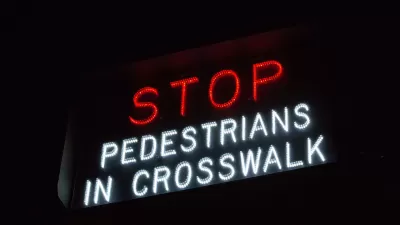A lack of effective lighting in streets, parks, and transit stations limits the places where many women and other vulnerable groups feel safe traveling at night.

A report from Transport for New South Wales highlights the disproportionate safety concerns faced by women in cities after dark, reports Elias Visontay in The Guardian.
In an Australian survey, almost two-thirds of female respondents expressed feeling unsafe walking at night, as opposed to 31 percent of men. “Despite research finding more lighting at night would be popular with many people, councils and other authorities often hesitate installing lights in public areas,” Visontay explains.
Advocates say they want to see a balance between the need to protect local wildlife with improving safety for pedestrians. In Melbourne, a series of high-profile murders prompted city officials to light a popular running path until midnight every day.
“It’s not just parks. Walking to and from public transport, as well as waiting at bus stops and train stations, can feel unsafe if there is no adequate lighting,” according to Professor Nicole Kalms, who studies the issue of gender-sensitive design.
The problem stems in part from the dominance of men in many aspects of the transportation planning field. “Transport technology company NEC has calculated that only 20% of senior transport roles in Australia are held by women, and women account for only 4% of CEOs in the industry.” This lack of women’s representation has led to poor outcomes when it comes to lighting and security, transit routes that serve women’s and children’s needs, and other aspects of mobility.
FULL STORY: ‘Not safe to run in the dark’: how inadequate lighting in public spaces is creating barriers for women

Alabama: Trump Terminates Settlements for Black Communities Harmed By Raw Sewage
Trump deemed the landmark civil rights agreement “illegal DEI and environmental justice policy.”

Study: Maui’s Plan to Convert Vacation Rentals to Long-Term Housing Could Cause Nearly $1 Billion Economic Loss
The plan would reduce visitor accommodation by 25% resulting in 1,900 jobs lost.

Planetizen Federal Action Tracker
A weekly monitor of how Trump’s orders and actions are impacting planners and planning in America.

Waymo Gets Permission to Map SF’s Market Street
If allowed to operate on the traffic-restricted street, Waymo’s autonomous taxis would have a leg up over ride-hailing competitors — and counter the city’s efforts to grow bike and pedestrian on the thoroughfare.

Parklet Symposium Highlights the Success of Shared Spaces
Parklets got a boost during the Covid-19 pandemic, when the concept was translated to outdoor dining programs that offered restaurants a lifeline during the shutdown.

Federal Homelessness Agency Places Entire Staff on Leave
The U.S. Interagency Council on Homelessness is the only federal agency dedicated to preventing and ending homelessness.
Urban Design for Planners 1: Software Tools
This six-course series explores essential urban design concepts using open source software and equips planners with the tools they need to participate fully in the urban design process.
Planning for Universal Design
Learn the tools for implementing Universal Design in planning regulations.
Caltrans
Smith Gee Studio
Institute for Housing and Urban Development Studies (IHS)
City of Grandview
Harvard GSD Executive Education
Toledo-Lucas County Plan Commissions
Salt Lake City
NYU Wagner Graduate School of Public Service





























